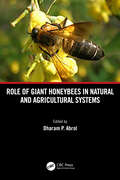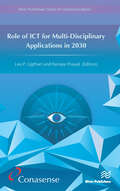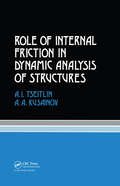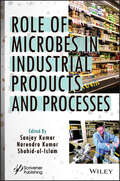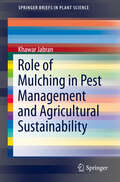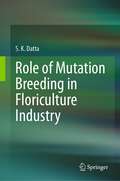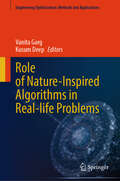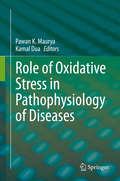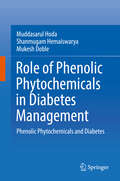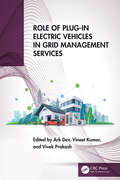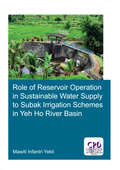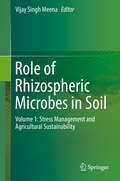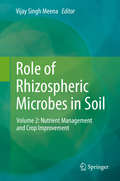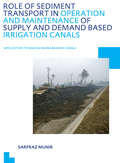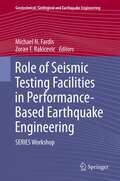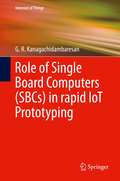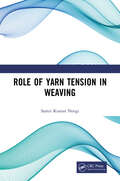- Table View
- List View
Role of Giant Honeybees in Natural and Agricultural Systems
by Dharam P. AbrolRole of Giant Honeybees in Natural and Agricultural Systems provides multidisciplinary perspective about the different facets of giant honeybees. Giant honeybees–Apis dorsata and Apis laboriosa are excellent pollinators of crops, fruits, and vegetables in cultivated and natural lanscapes. Their large size, long foraging range, and large work force make them the most spectacular of all honeybee species for crop pollination and honey production. Due to their decline, ecosystems and global food security are being threatened. This book is the first of its kind which deals in detail on varied aspects of giant honeybee biology, management, conservation strategies for protecting biodiversity and enhancing crop productivity. It aims to promote a large, diverse, sustainable, and dependable bee pollinator workforce that can meet the challenge for optimizing food production in 21st century. SALIENT FEATURES: Covers the latest information on various aspects of biology of giant honeybees and brings the latest advances together in a single volume for researchers and advanced level students Provides an excellent source of advanced study material for academics, researchers and students and programme planners Provides an excellent source of livelihood in mountainous areas and marginal farmers Deals with biology, management and conservation strategies for protecting biodiversity and enhancing crop productivity. Excellent pollinator of tropical and subtropical crops, fruits, vegetables, etc. less prone to diseases and enemies This book will be useful for pollination biologists, honeybee biologists, scientists working in agriculture, animal behavior, conservation, biology, ecology, entomologists, environmental biologists, etc.
Role of ICT for Multi-Disciplinary Applications in 2030 (River Publishers Series In Communications Ser.)
by Ramjee Prasad Leo P. LigthartThe theme of this book is “Role of ICT for multi-disciplinary applications in 2030”, which is absolutely appropriate to explore with regard to the CONASENSE vision of looking at services utilizing the Communications, Navigation, Sensing and Services (CONASENSE) paradigm in a period of 20-50 years from now. The vision of CONASENSE society is to bring about active integration of the three worlds of communications, navigation and local/remote sensing – that have been apart for years require a multidisciplinary approach. This 4th Communication, Navigation, Sensing and Services (CONASENSE) book brings together in contributions from another society, namely, Global ICT Standardization Forum for India (GISFI).Technical topics discussed in the book include: • Wireless Sensor Networks• Advanced IoT and M2M• Future Space Communications Infrastructure• ICT Networks for CONASENSE in 2030• International ICT Research• Secure Vehicular Ad-Hoc Networks• Heterodox Networks• CONASENSE Innovation Era• CONASENSE at NanoscaleThus the book provides a rich and interesting coverage of diverse aspects concerning multi-disciplinary applications.
Role of Internal Friction in Dynamic Analysis of Structures: Russian Translations Series 81
by A.A. Kusainov A.I. TseitlinImprovement in the methods of analysis of structures, machines, aircrafts and ships is one of the most important problems in engineering today. The computational aspects of this problem are being tackled successfully due to developments in computer science. However, for an adequate description of the physical properties of structures, especially those made of newer, non- traditional materials, it is essential to further study their behaviour under different load and kinematic conditions and to develop appropriate physical models that provide a comprehensive and correct description of the actual state of deformation. The objective of this book is to adopt a unified approach for describing the large number of models of internal friction and to offer recommendations regarding the methods of taking it into account at the time of dynamic analysis. It is also intended to provide a comprehensive analysis of the various models, accompanied by detailed solutions of specific problems, which could serve as examples for dynamic analysis of real structures taking into account the effect of internal friction.
Role of Microbes in Industrial Products and Processes
by Sanjay Kumar Narendra Kumar Shahid-Ul-IslamROLE OF MICROBES IN INDUSTRIAL PRODUCTS AND PROCESSES The book covers recent breakthroughs and highlights the major role microbes play in industrial products and processes. With the advent of industrial biotechnology, microbes became popular as cell factories, and with the recent advancements in recombinant DNA technology, the application of microorganisms in various sectors has increased enormously for the development of various processes and products. Role of Microbes in Industrial Products and Processes covers recent breakthroughs and highlights the major role microbes play in industrial products and processes. It mainly focuses on the bio-refinery concept where bio-energy production and wastewater treatment are done simultaneously using micro-algae. Additionally, this book describes the role of microbes involved in the production of various enzymes, organic acids, and bio-polymers. It also provides detailed insight on modeling and simulation of bioprocess for the production of sugar alcohol; recovery of value-added products from organic waste using microbes is also reported. Detailed insights into the treatment of wastewater released from various industries, especially pharmaceutical wastewater, are given. Audience The book is intended for researchers, scientists, and postgraduates in chemical/biochemical engineering and bioprocess engineering, and others working in the domain of food microbiology, bioenergy/refinery, waste valorization to value-added products, and microbial production of bioplastics, sugar alcohols, enzymes, and organic acids.
Role of Mulching in Pest Management and Agricultural Sustainability (SpringerBriefs in Plant Science)
by Khawar JabranThis book provides the concepts, techniques, and recent developments with regard to use of mulches in agriculture, utility of mulches for non-chemical pest control, and sustainability of crop production systems. Non-conventional means of improving the sustainability of crop production and pest control are required in the wake of environmental concerns over the use of conventional pesticides as well as the intensive use of land resources. Mulches have been used in agriculture for various purposes; however, there has been an increase in their use more recently, and scientists around the world have conducted more research to explore the benefits of mulching in various agricultural systems. Mulches have been found advantageous in non-chemical pest control, soil and water conservation, improving fertility, and improving microbial activities in the soil. While this is a topic of current importance, the information use of mulches in agricultural fields is rarely compiled in one comprehensive location to provide a full account of various aspects of mulches and their utility. This book will be helpful for researchers, growers, and students.
Role of Mutation Breeding In Floriculture Industry
by S.K DattaThis monograph provides a comprehensive review of many aspects of current interest and progress on mutation research on vegetatively propagated ornamentals. It covers almost all aspects of induced mutagenesis on ornamental plants. Chapters in this title provides information about mutation technology for the development of new ornamental varieties. Taking all aspects together, it is an excellent reference book of updated information on mutation breeding on vegetatively propagated ornamentals. Floriculture has become a very important industry in many countries as a result of science-based techniques and a steady supply of improved plant materials. The induced mutation is now recognized as well as a standardized valuable tool for the development of new varieties. The book provides an authoritative review account of all important aspects related to inducing mutagenesis in the field of ornamental crops. The primary objective of the book is to give a coherent and concise account of earlier work with an emphasis on recent developments. The knowledge generated so far has been reviewed in this book which can work as a knowledge base to prepare guidelines for future planning of successful application of mutation technology for the floriculture industry. The information in the book is an excellent informative document for researchers, teachers, students, and breeders for understanding the application of induced mutations and planning future strategies for the development of new ornamental varieties for the floriculture industry.
Role of Nature-Inspired Algorithms in Real-life Problems (Engineering Optimization: Methods and Applications)
by Kusum Deep Vanita GargThe book includes nature-inspired optimization techniques and their applications. It offers recent trends in the field of nature-inspired algorithms for solving real-life problems in various fields related to manufacturing, artificial intelligence, finance, etc. Nature-inspired optimization techniques are not only useful but also needed for solving open-ended problems. Understanding nature-inspired techniques and their importance for solving real-life problems can open many directions for researchers and academicians. This book will be helpful in acquiring knowledge of nature-inspired optimization techniques in various fields of real-life applications.
Role of Oxidative Stress in Pathophysiology of Diseases
by Pawan K. Maurya Kamal DuaThis book illustrates the importance and significance of oxidative stress in the pathophysiology of various human diseases. The book initially introduces the phenomenon of oxidative stress, basic chemical characteristics of the species involved and summarizes the cellular oxidant and anti-oxidant system and the cellular effects and metabolism of the oxidative stress. In addition, it reviews the current understanding of the potential impact of oxidative stress on telomere shortening, aging, and age-related diseases. It also examines the role of oxidative stress in chronic diseases, including cancer, diabetes, cardiovascular diseases, and neurodegenerative disorders. Further, the book presents novel technologies for the detection of oxidative stress biomarkers using nanostructure biosensors, as well as in vitro and in vivo models to monitor oxidative stress. Lastly, the book addresses the drug delivery carriers that can help in combating oxidative stress.
Role of Phenolic Phytochemicals in Diabetes Management: Phenolic Phytochemicals and Diabetes
by Mukesh Doble Muddasarul Hoda Shanmugam HemaiswaryaThis book summarizes the latest research trends in phytophenolic therapy for the management of diabetes. It discusses the various mechanisms of action of phytophenolics present in food, fruits and plants that can be used to control/reverse diabetic conditions. Further, it addresses the synergistic interactions of phytophenolics with anti-diabetic drugs, as understanding them can yield valuable insights for complementary and alternative medicine. In closing, it discusses the important aspects of nanotechnology-based targeted delivery and improving the bioavailability of phenolic phytochemicals, two major areas of research in phytotherapy of diabetes.
Role of Plug-in Electric Vehicles in Grid Management Services
by Vineet Kumar Ark Dev Vivek PrakashThe increasing integration of plug-in electric vehicles (PEVs) into power grids has sparked new challenges and opportunities in energy management, grid stability, and sustainable power solutions. Role of Plug-in Electric Vehicles in Grid Management Services provides a comprehensive exploration of how PEVs are transforming modern power networks, offering solutions for demand-side management, vehicle-to-grid (V2G) integration, and energy storage. This book presents in-depth discussions on emerging technologies, smart charging strategies, and optimization methods to ensure a resilient and efficient grid infrastructure.With contributions from leading researchers and industry experts, this book delves into critical areas such as the impact of EV integration on grid stability, smart charging infrastructure, battery health monitoring using AI, and advanced power electronic converters for seamless EV-grid interactions. Covering both theoretical foundations and practical applications, this book serves as an essential resource for researchers, policymakers, and professionals working at the intersection of electric mobility and power systems.Key Features• A detailed review of the impact of EV integration on power grids and energy transition.• Cutting-edge insights into smart charging infrastructure and multi-criteria decision-making for lithium battery selection.• AI and machine learning applications for battery health monitoring and key parameter estimation.• Novel optimization techniques for multi-area microgrids incorporating energy storage and EVs.• Advanced power electronics designs, including DC-DC converters and resonant converters for efficient EV charging.• Exploration of future trends and research directions in EV-integrated grids.This book is an invaluable reference for academics, engineers, and researchers in electrical engineering, renewable energy, and electric vehicle technology. It will also benefit industry professionals involved in power system planning, grid management, and electric mobility solutions.
Role of Reservoir Operation in Sustainable Water Supply to Subak Irrigation Schemes in Yeh Ho River Basin: Learning From Experiences of Ancient Subak Schemes For Participatory Irrigation System Management in Bali
by Mawiti Infantri YektiA Subak irrigation scheme, primarily in Bali, Indonesia concerns an irrigation system of which the construction, operation and management are based on agreed principles of technology, management of agriculture and religious community. Subak systems have been well known since the 9th Century. As a manifestation of the Cultural Landscape of Bali Province the Subak schemes are since June, 2012 included in the World Heritage List of UNESCO. These systems are managed by a Subak Association based on the Tri Hita Karana philosophy - harmony between human beings and God, harmony between people and nature, and harmony between people and people. The problem of insufficient water in the dry season developed in the Yeh Ho River Basin. Because of this the main objective of this study was to develop an optimal reservoir operation strategy in relation to the water supply of the Subak irrigation schemes, capable to support agricultural productivity at upstream, midstream and downstream level. Based on a Generic Algorithm the RIBASIM model was applied using the dependable 80% of discharge and shifting the start of land preparation. The results provide evidence that the cropping pattern of the fifth scenario results in an overall optimal agriculture production of the Subak schemes. The recoverable flow considered in the river basin scheme model plays an important role in the optimisation. Nevertheless, if a normal hydro-climate occurs, the other scenarios, especially the first scenario, can be applied as well. This reflects the applicability of the Tri Hita Karana philosophy on harmony among people and harmony among people and nature.
Role of Rhizospheric Microbes in Soil: Volume 2: Nutrient Management And Crop Improvement
by Vijay Singh MeenaIn any ecosystem, plant and microbe interaction is inevitable. They not only co-exist but also support each other’s survival and provide sustenance in stressful environments. Agro-ecosystems in many regions around the globe are affected by high temperatures, soil salinity/alkalinity, low pH and metal toxicity. High salinity and severe draught are other major constraints affecting agricultural practices and also plants in the wild. A major limiting factor affecting global agricultural productivity is environmental stresses. Apart from decreasing yield, they also have a devastating impact on plant growth. Plants battle with various kind of stresses with the help of symbiotic associations with the rhizospheric microbes. Naturally occuring plant-microbe interactions facilitate the survival of plants under these stressful conditions.The rhizosphere consists of several groups of microbes, plant growth-promoting bacteria (PGPB) is one such group of microbes that assists plants in coping with multiple stresses and also promote plant growth. These efficient microbes support the stress physiology of the plants and can be extremely useful in solving agricultural as well food- security problems.This book provides a detailed, holistic description of plant and microbe interaction. It elucidates various mechanisms of nutrient management, stress tolerance and enhanced crop productivity in the rhizosphere, discussing The rhizospheric flora and its importance in enhancement of plant growth, nutrient content, yield of various crops and vegetables as well as soil fertility and health. Divided into two volumes, the book addresses fundamentals, applications as well as research trends and new prospects for agricultural sustainability. Volume 1: Stress Management and Agricultural Sustainability, includes chapters offering a broad overview of plant stress management with the help of microbes. It also highlights the contribution of enzymatic and molecular events occurring in the rhizosphere due to plant microbe interactions, which in turn help in the biological control of plant disease and pest attacks. Various examples of plant microbe interaction in rhizospheric soil are elaborated to facilitate the development of efficient indigenous microbial consortia to enhance food and nutritional security. Providing a comprehensive information source on microbes and their role in agricultural and soil sustainability, this timely research book is of particular interest to students, academics and researchers working in the fields of microbiology, soil microbiology, biotechnology, agronomy, and the plant protection sciences, as well as for policy makers in the area of food security and sustainable agriculture.
Role of Rhizospheric Microbes in Soil: Volume 2: Nutrient Management and Crop Improvement
by Vijay Singh MeenaIn any ecosystem, plant and microbe interaction is inevitable. They not only co-exist but also support each other’s survival and also provide for sustenance in stressful environment. Agro-ecosystems of many regions around the globe are affected by multi-stress. Major limiting factors affecting the agricultural productivity worldwide are environmental stresses. Apart from decreasing yield they introduce devastating impact on plant growth as well. Plants battle with various kind of stresses with the help of symbiotic association with the microbes in the rhizosphere. Naturally existing plant-microbe interaction facilitates survival of plants under these stressful conditions. Rhizosphere consists of many groups of microbes, plant growth-promoting bacteria (PGPB) is one such group of microbes which assist plants in coping with multiple stresses and in plant growth as well. These microbes help in stress physiology of the plants and can be extremely useful in solving agricultural as well food security problems. The proposed book is split into two parts, with an aim to provide comprehensive description and highlight a holistic approach. It elucidates various mechanisms in rhizosphere of nutrient management, stress tolerance and enhanced crop productivity. The book discusses rhizospheric flora and its importance in enhancement of plant growth, nutrient content, yield of various crops and vegetables as well as soil fertility and health. Both volumes of the book addresses fundamentals, applications as well as research trends and new prospects of agricultural sustainability. Volume 2: Nutrient Management and Crop Improvement, contains chapters which cover a broad overview of plant growth promoting activities of microbes. This proposed book also highlights the contribution of nitrogen, phosphorus, potassium, iron and zinc-solubilizing microbes from rhizospheric soil to develop efficient indigenous microbial consortia to enhance the food and nutritional security. With the given content and layout the proposed book will be an all-inclusive collection of information, which will be useful for students, academicians, researchers working in the field of rhizospheric mechanisms, agricultural microbiology, soil microbiology, biotechnology, agronomy and sustainable agriculture and also for policy makers in the area of food security and sustainable agriculture. It will be of special interest to both academics and professionals working in the fields of microbiology, soil microbiology, biotechnology and agronomy, as well as the plant protection sciences. Timely, this edited and research book provides an essential and comprehensive source of material from basic to advance findings on microbes and their role in agricultural and soil sustainability.
Role of Sediment Transport in Operation and Maintenance of Supply and Demand Based Irrigation Canals: UNESCO-IHE PhD Thesis (IHE Delft PhD Thesis Series)
by Sarfraz MunirThis work describes the role of sediment transport in the operation and maintenance of demand-based downstream controlled irrigation canals. Sediment deposition in these irrigation canals severely affects the operation of the automatic flow control system. The book also discusses sediment transport modelling in irrigation canals. A simplified 1-D m
Role of Seismic Testing Facilities in Performance-Based Earthquake Engineering
by Michael N. Fardis Zoran T. RakicevicNowadays research in earthquake engineering is mainly experimental and in large-scale; advanced computations are integrated with large-scale experiments, to complement them and extend their scope, even by coupling two different but simultaneous tests. Earthquake engineering cannot give answers by testing and qualifying few, small typical components or single large prototypes. Besides, the large diversity of Civil Engineering structures does not allow drawing conclusions from only a few tests; structures are large and their seismic response and performance cannot be meaningfully tested in an ordinary lab or in the field. So, seismic testing facilities should be much larger than in other scientific fields; their staff has to be resourceful, devising intelligent ways to carry out simultaneously different tests and advanced computations. To better serve such a mission European testing facilities and researchers in earthquake engineering have shared their resources and activities in the framework of the European project SERIES, combining their research and jointly developing advanced testing and instrumentation techniques that maximize testing capabilities and increase the value of the tests. This volume presents the first outcomes of the SERIES and its contribution towards Performance-based Earthquake Engineering, i.e., to the most important development in Earthquake Engineering of the past three decades. The concept and the methodologies for performance-based earthquake engineering have now matured. However, they are based mainly on analytical/numerical research; large-scale seismic testing has entered the stage recently. The SERIES Workshop in Ohrid (MK) in Sept. 2010 pooled together the largest European seismic testing facilities, Europe's best experts in experimental earthquake engineering and select experts from the USA, to present recent research achievements and to address future developments. Audience: This volume will be of interest to researchers and advanced practitioners in structural earthquake engineering, geotechnical earthquake engineering, engineering seismology, and experimental dynamics, including seismic qualification.
Role of Single Board Computers (Internet of Things)
by G. R. KanagachidambaresanThis book presents how to program Single Board Computers (SBCs) for Internet of Things (IoT) rapid prototyping with popular tools such as Raspberry Pi, Arduino, Beagle Bone, and NXP boards. The book provides novel programs to solve new technological real-time problems. The author addresses programming, PCB design and Mechanical Cad design all in single volume, easing learners into incorporating their ideas as prototype. The aim of the book is to provide programming, sensors interfacing, PCB design, and Mechanical Cad design to and create rapid prototyping. The author presents the methodologies of rapid prototyping with KiCAD design and Catia software, used to create ready to mount solutions. The book covers scripting- based and drag/drop- based programming for different problems and data gathering approach.
Role of Yarn Tension in Weaving
by Samir Kumar NeogiNo cloth can be woven without desired and adequate tensions of its constituent warp and weft yarns. This book explains the crucial role of yarn tension in weaving and discusses its various aspects and effects on cloth characteristics. The subject matter of this book includes – Yarn tension at the weaving preparatory process Warp tension measurement General form of weft tension variation Effects of loom settings and other factors on warp tension Effects of yarn tensions on loom performance Print edition not for sale in South Asia (India, Sri Lanka, Nepal, Bangladesh, Pakistan and Bhutan)
Roll Forming Handbook (Manufacturing Engineering and Materials Processing)
by George T. HalmosRoll forming is one of the most widely used processes in the world for forming metals. Most of the existing knowledge resides in various journal articles or in the minds of those who have learned from experience. Providing a vehicle to systematically collect and share this important knowledge, the Roll Forming Handbook presents the first comprehens
Roll-to-Roll Manufacturing: Process Elements and Recent Advances
by Jehuda Greener Glen Pearson Miko CakmakA single-volume resource featuring state-of-the art reviews of key elements of the roll-to-roll manufacturing processing methodology Roll-to-roll (R2R) manufacturing is an important manufacturing technology platform used extensively for mass-producing a host of film-type products in several traditional industries such as printing, silver-halide photography, and paper. Over the last two decades, some of the methodologies and know-how of R2R manufacturing have been extended and adapted in many new technology areas, including microelectronics, display, photovoltaics, and microfluidics. This comprehensive book presents the state-of-the-art unit operations of the R2R manufacturing technology, providing a practical resource for scientists, engineers, and practitioners not familiar with the fundamentals of R2R technology. Roll-to-Roll Manufacturing: Process Elements and Recent Advances reviews new developments in areas such as flexible glass, display, and photovoltaics and covers a number of process innovations implemented recently to extend and improve the capabilities of traditional R2R lines. It covers such topics as: coating and solidification processes, in-line vacuum deposition, drying, web handling and winding, polymer film substrates, novel hybrid composite films, flexible solar cells and more. Additionally, this book: Examines key elements (unit operations) of the R2R technology, and discusses how these elements are utilized and integrated to achieve desired process efficiencies in a host of applications. Illustrates several established and novel application areas where R2R processing is utilized in current or future products. Discusses process design methodology and key advantages of R2R manufacturing technology over batch or sheet-to-sheet operations. Roll-to-Roll Manufacturing: Process Elements and Recent Advances is an ideal book for undergraduate and graduate students in various science and engineering disciplines, as well as for scientists, engineers, and technical and business leaders associated in any way with the development, commercialization, and manufacture of a variety of film products.
Roll-to-Roll Vacuum Deposition of Barrier Coatings
by Charles A. BishopIt is intended that the book will be a practical guide to provide any reader with the basic information to help them understand what is necessary in order to produce a good barrier coated web or to improve the quality of any existing barrier product.<P><P> After providing an introduction, where the terminology is outlined and some of the science is given (keeping the mathematics to a minimum), including barrier testing methods, the vacuum deposition process will be described. In theory a thin layer of metal or glass-like material should be enough to convert any polymer film into a perfect barrier material. The reality is that all barrier coatings have their performance limited by the defects in the coating. <P>This book looks at the whole process from the source materials through to the post deposition handling of the coated material. This holistic view of the vacuum coating process provides a description of the common sources of defects and includes the possible methods of limiting the defects. This enables readers to decide where their development efforts and money can best be used to improve the barrier performance of their own process or materials. The 2nd edition contains at least 20% new material including additional barrier testing techniques that have been developed and testing and cleaning equipment brought to market since the 1st edition was published in 2010. The topic of adhesion is covered in more detail and there is a section on the Hanson Solubility Parameter which is a method of predicting the solubility of gases or liquids in materials.
Roller-Compacted Concrete Dams (ICOLD Bulletins Series #177)
by Cigb IcoldICOLD Bulletin 177 ‘Roller-Compacted Concrete Dams’ presents the state-of-the-art on roller-compacted concrete technology for dams, incorporating the advances of the RCC technology for dams over the last 15 years since the previous Bulletin on the topic was released in 2003. Hence, the present ICOLD Bulletin 177 supersedes ICOLD Bulletin 126 (‘Roller-compacted concrete dams - State of the art and case histories’, published in 2003) and ICOLD Bulletin 75 (‘Roller-Compacted Concrete for Gravity Dams’ published in 1989). While roller-compacted concrete technology could have still been considered a new technology in 2003, it is now true to say that construction by roller-compaction has become the standard approach for large concrete gravity dams. This Bulletin addresses all aspects of the planning, design, construction and performance of RCC in dams. Mixture proportioning and quality control are discussed and a comprehensive listing of references is included. Many aspects of RCC in dams have become better understood since the publication of Bulletin No 126 and the present Bulletin contains less information on the particular approaches applied in different countries, but includes more comprehensive information particularly in relation to design, mixture proportioning and construction. With greater understanding, it has further been possible to highlight more definitively the requirements of successful RCC dams, as well as the pitfalls and difficulties that can be associated with RCC dam design and construction. Le Bulletin CIGB 177, intitulé « Barrages en Béton Compacté au Rouleau » présente les dernières avancées en matière de technologie du béton compacté au rouleau pour les barrages intégrant les progrès de la technologie BCR pour les barrages au cours des 15 dernières années, depuis que le dernier bulletin sur le sujet a été publié en 2003. Par conséquent, le bulletin 177 remplace le bulletin 126 (« Barrages en béton compacté au rouleau - Technique actuelle et exemples », publié en 2003) et le bulletin 75 (« Béton compacté au rouleau pour barrages-poids - Technique actuelle » publié en 1989). Alors que la technologie du BCR pourrait encore être considérée comme une nouvelle technologie en 2003, il est maintenant vrai de dire que la construction par le compactage par rouleaux est devenue l'approche standard pour les grands barrage-poids en béton. Ce bulletin aborde tous les aspects de la planification, de la conception, de la construction et de la performance du BCR dans les barrages. Le dosage du mélange et le contrôle de la qualité sont discutés et une liste exhaustive des références est incluse. De nombreux aspects du BCR dans les barrages sont mieux compris depuis la publication du Bulletin no 126. Le présent bulletin contient moins d'informations sur les approches particulières appliquées dans différents pays, mais comprend des informations plus complètes notamment en ce qui concerne la conception, le dosage du mélange et la construction. Avec une plus grande compréhension, il a été possible de mettre en évidence les exigences des barrages en BCR réussis, ainsi que les pièges et les difficultés qui peuvent être associés à la conception et la construction du barrage en BCR.
Rolling Contact Fatigue in a Vacuum
by Michael Danyluk Anoop DhingraThis book deals with wear and performance testing of thin solid film lubrication and hard coatings in an ultra-high vacuum (UHV), a process which enables rapid accumulation of stress cycles compared with testing in oil at atmospheric pressure. The authors' lucid and authoritative narrative broadens readers' understanding of the benefits of UHV testing: a cleaner, shorter test is achieved in high vacuum, disturbance rejection by the deposition controller may be optimized for maximum fatigue life of the coating using rolling contact fatigue testing (RCF) in a high vacuum, and RCF testing in UHV conditions enables a faster study of deposition control parameters. In short, Rolling Contact Fatigue in a Vacuum is an indispensable resource for researchers and engineers concerned with thin film deposition, solar flat panel manufacturing, physical vapor deposition, MEMS manufacturing (for lubrication of MEMS), tribology in a range of industries, and automotive and marine wear coatings for engines and transmissions.
Rolling of Advanced High Strength Steels: Theory, Simulation and Practice
by Jingwei Zhao Zhengyi JiangAdvanced high strength steels (AHSSs) for auto-making are primarily produced by rolling, plus heat treatment technologies if necessary. However, due to the metallurgical complexity of AHSSs, it is impossible to roll all of the AHSS grades in a rolling mill with the same rolling technology. Each of AHSSs has unique applications in vehicles, and specified rolling technologies are required to produce high quality AHSS products where they might be the best employed to meet performance demands of the automotive parts. Such background has prompted the publication of this scholarly book in the area of rolling of AHSSs with a purpose of providing readers with a valuable technical document that can be used in the research and development of AHSSs for automotive and other manufacturing industries. With contributors from USA, Germany, Poland, Italy, Spain, Austria, Australia, China, India and Iran, the book highlights the latest advances in rolling technologies of AHSSs. It focuses on the theory, simulation and practice of the rolling of AHSSs: The book introduces the history, types and advances of AHSSs and their processes; proposes new theory that is applicable to the rolling of AHSSs, presents mathematical and numerical modelling of AHSSs in rolling; covers thermomechanical processing technologies of AHSSs; provides case studies on the rolling practice of the most popular AHSSs and includes other rolling-related technologies of AHSSs. The book will be useful for both theoretical and applied research aimed at AHSSs rolling technologies, and will be a scientific and valuable literature for the metallurgists, engineers, materials scientists, academics and graduate students who are studying and working with AHSSs and their rolling technologies worldwide.
Roloff/Matek Entwickeln Konstruieren Berechnen: Praxisnahe Beispiele mit Lösungsvarianten
by Bernhard Fleischer Hans TheumertDieses Lehr- und Übungsbuch ergänzt das System der Roloff/Matek Maschinenelemente und schlägt auf anschauliche Weise eine Brücke zwischen der Betrachtung einzelner Fachdisziplinen in der Konstruktion und dem Blick auf das Ganze. Dabei wird der vollständige Konstruktionsprozess der VDI-Richtlinie 2221 an ausgewählten und praxisrelevanten Beispielen dargestellt. Dieser reicht von den Kundenanforderungen bis zur fertigungsgerechten Werkstattzeichnung. Die Aufgaben nehmen dabei in Umfang und Anspruch über das Buch hinweg zu. Es werden Alternativlösungen vorgestellt und deren Vor- und Nachteile bewertet. Die Berechnung der Maschinenelemente erfolgt konsequent mittels Verweisen an der 27. Auflage. Das didaktische Konzept macht dieses Werk zudem besonders geeignet für das Selbststudium.
Roloff/Matek: Praxisnahe Beispiele mit Lösungsvarianten
by Bernhard Fleischer Hans TheumertDieses seit über 6 Auflagen hinweg gut eingeführte Lehr- und Übungsbuch ergänzt das Roloff/Matek Lehr- und Lernsystem. Es lehnt sich an die VDI-Richtlinie 2221 an und stellt den kompletten Konstruktionsprozess an ausgewählten praxisnahen Beispielen anschaulich dar. In zunehmender Komplexität werden Konstruktionen beginnend mit den Anforderungen des Kunden bis hin zu den fertigungsgerechten Werkstattzeichnungen behandelt. Es werden Alternativlösungen vorgestellt und deren Vor- und Nachteile bewertet. Die Berechnung der Maschinenelemente erfolgt konsequent mittels Verweisen an der aktuellen 24. Auflage des Lehrbuchs Roloff/Matek Maschinenelemente. Auf Grund der didaktischen Konzeption kann dieses Buch sehr gut zum Selbststudium eingesetzt werden.
